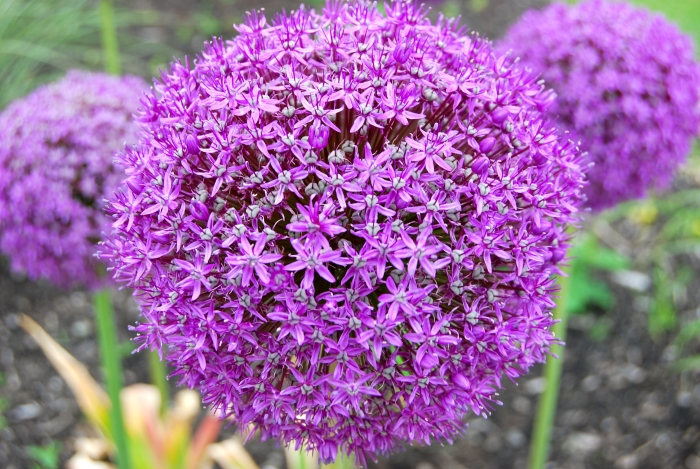Giant Onion
(Allium giganteum)
Giant Onion (Allium giganteum)
/
/

Wadester16
CC BY-SA 3.0
Image By:
Wadester16
Recorded By:
Copyright:
CC BY-SA 3.0
Copyright Notice:
Photo by: Wadester16 | License Type: CC BY-SA 3.0 | License URL: https://creativecommons.org/licenses/by-sa/3.0 | Uploader: MattWade | Publisher: Wikimedia Commons | Title: PurpleBallFlower.JPG | Notes: {{Information |Description={{de|1=Knoblauchblüte}} |Source=Eigenes Werk (own work) |Author=[[User:Kickof|Kickof]] |Date=2009-07-07 |Permission= |other_versions= }} [[Category:Allium sativum]] |



























Estimated Native Range
Summary
Allium giganteum, commonly known as Giant Onion, is a deciduous perennial bulb native to Central Asia, specifically to regions with a continental climate characterized by dry summers and cold winters. It is the tallest species of Allium in common cultivation, reaching up to 1.5 meters (4.9 ft) in height. The plant features striking globes of intense purple flowers, known as umbels, which bloom in early to midsummer and are highly attractive to pollinators. Following the flowering period, the plant produces distinctive seed heads that add textural interest to the garden. The foliage is bluish-green and strap-shaped, adding to the plant’s ornamental value.
Giant Onion is valued for its dramatic floral display and architectural height, making it a focal point in borders and ornamental gardens. It is also used in cut flower arrangements and as a dried flower. ’Globemaster’, a popular cultivar, is noted for its shorter stature at 80 centimeters (31 in) and larger, deep violet umbels measuring 15–20 centimeters (5.9–7.9 in) across. Both the species and the ’Globemaster’ cultivar have received the Royal Horticultural Society’s Award of Garden Merit, attesting to their performance and beauty in gardens. For optimal growth, Giant Onion requires full sun exposure and well-drained soil, although it is tolerant of a range of soil types. It is generally low-maintenance but benefits from regular watering during the growing season. It is hardy in USDA zones 6–10, where it can be left in the ground year-round. Potential problems include onion fly and thrips, though these are not commonly severe.CC BY-SA 4.0
Giant Onion is valued for its dramatic floral display and architectural height, making it a focal point in borders and ornamental gardens. It is also used in cut flower arrangements and as a dried flower. ’Globemaster’, a popular cultivar, is noted for its shorter stature at 80 centimeters (31 in) and larger, deep violet umbels measuring 15–20 centimeters (5.9–7.9 in) across. Both the species and the ’Globemaster’ cultivar have received the Royal Horticultural Society’s Award of Garden Merit, attesting to their performance and beauty in gardens. For optimal growth, Giant Onion requires full sun exposure and well-drained soil, although it is tolerant of a range of soil types. It is generally low-maintenance but benefits from regular watering during the growing season. It is hardy in USDA zones 6–10, where it can be left in the ground year-round. Potential problems include onion fly and thrips, though these are not commonly severe.CC BY-SA 4.0
Plant Description
- Plant Type: Bulb
- Height: 3-4 feet
- Width: 1.5-2 feet
- Growth Rate: Rapid
- Flower Color: Pink, Purple
- Flowering Season: Spring, Summer
- Leaf Retention: Deciduous
Growth Requirements
- Sun: Full Sun
- Water: Medium
- Drainage: Slow, Medium
Common Uses
Bee Garden, Bird Garden, Border Plant, Butterfly Garden, Deer Resistant, Drought Tolerant, Edible*Disclaimer: Easyscape's listed plant edibility is for informational use. Always verify the safety and proper identification of any plant before consumption., Fragrant, Hummingbird Garden, Low Maintenance, Rabbit Resistant, Rock Garden, Showy Flowers, Street Planting
Natural Habitat
Native to regions with a continental climate in Central Asia
Other Names
Common Names: Ornamental Onion, Riesenlauch, Ail Géant De L’Himalaya, Oignon Géant, Jättelök
Scientific Names: , Allium giganteum, Allium procerum,
GBIF Accepted Name: Allium giganteum Regel